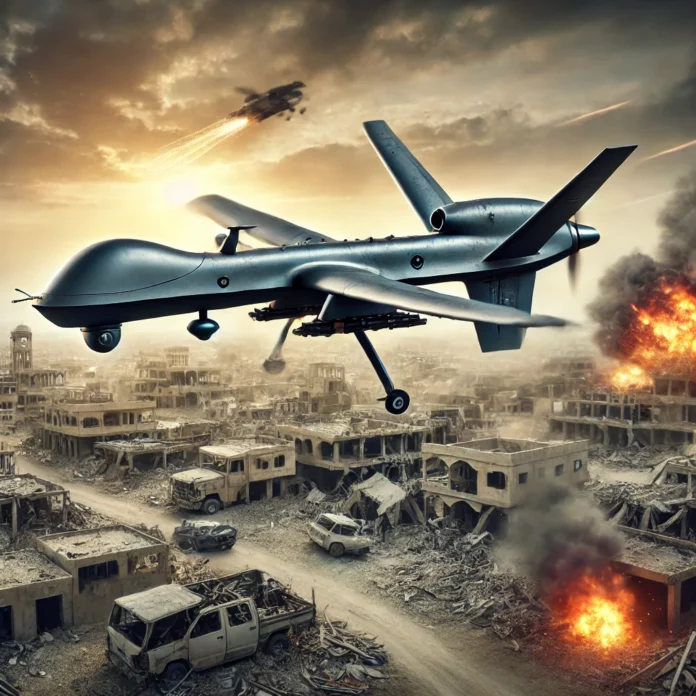Ukrainian drones have become a critical component in the country’s defense strategy during the ongoing conflict with Russia. These UAVs provide essential capabilities such as reconnaissance, precision strikes, and surveillance, allowing Ukraine to maintain an edge on the battlefield despite being outnumbered. From military-grade drones like the Bayraktar TB2 to commercial drones such as the DJI Mavic, Ukraine has adapted a range of UAVs for both combat and intelligence-gathering missions.
Bayraktar TB2: The Backbone of Ukraines Drones
The Bayraktar TB2, a Turkish-made medium-altitude, long-endurance (MALE) UAV, has been one of Ukraine’s most effective tools in targeting Russian forces. Known for its ability to carry out reconnaissance missions and precision airstrikes, the Bayraktar TB2 has become a symbol of Ukraine’s resilience.
- Key Features:
- Wingspan: 12 meters
- Payload Capacity: 150 kg
- Armament: Can carry laser-guided munitions
- Endurance: 24 hours of continuous flight
- Operational Range: 150 km
The Bayraktar TB2 has been used for targeting Russian armored vehicles, artillery systems, and supply convoys. Its laser-guided munitions enable it to hit targets with precision, often striking Russian forces from beyond their air defense range. In the early days of the conflict, videos circulated showing Bayraktar TB2s destroying Russian tanks and other military equipment, significantly boosting Ukrainian morale and causing logistical challenges for Russian forces.
Switchblade and Phoenix Ghost: Kamikaze Drones
Ukraine has also employed kamikaze drones such as the Switchblade and Phoenix Ghost, both of which were supplied by the United States. These loitering munitions have been instrumental in precision targeting, particularly against artillery and radar systems.
Switchblade Ukrainian Drones
The Switchblade 300 and Switchblade 600 are portable, loitering munitions that can be launched by a single operator. They are designed to hover over the battlefield, identify targets, and perform kamikaze-style attacks on enemy positions.
- Switchblade 300:
- Range: 10 km
- Endurance: 15 minutes
- Warhead: Small explosive charge suitable for soft targets like troops or light vehicles
- Switchblade 600:
- Range: 40 km
- Endurance: 40 minutes
- Warhead: Capable of destroying armored vehicles
Phoenix Ghost
The Phoenix Ghost, also a loitering munition, was specifically designed for use in Ukraine. While its exact specifications are classified, it is known to be capable of both loitering and direct strike missions. It has been used to target Russian radar systems, artillery pieces, and logistics hubs.
Aerorozvidka R18: Surveillance and Bomblet Ukrainian Drones
The Aerorozvidka R18 is an indigenous Ukrainian drone developed for surveillance and bombing missions. Equipped with thermal imaging cameras and capable of flying in stealth mode, the R18 has played a crucial role in nighttime operations, allowing Ukrainian forces to track Russian movements and strike targets under the cover of darkness.
- Key Features:
- Thermal Imaging: Provides detailed visuals even at night or in adverse weather conditions
- Bomblet Drops: Equipped with bomblets for targeting Russian vehicles and positions
The R18 has been instrumental in disrupting Russian supply lines, often targeting logistical convoys and ammunition depots. Its ability to deliver small payloads of explosives makes it ideal for hit-and-run tactics, causing damage while minimizing the drone’s risk of detection.
DJI Mavic: Commercial Ukrainian Drones in Combat
While many of the drones used by Ukraine are military-grade, commercial drones like the DJI Mavic have also played an important role in combat operations. Originally designed for civilian use, the DJI Mavic has been modified by Ukrainian forces to carry out military missions, including reconnaissance, surveillance, and even combat operations by being fitted with explosives. These drones have proven to be cost-effective and relatively easy to acquire, making them a vital tool for gathering intelligence and disrupting enemy movements.
- Key Features:
- Compact Design: Easily transportable and can be launched quickly by small teams.
- High-Resolution Camera: Allows for detailed surveillance and target acquisition.
- Adaptability: Modified to carry grenades or small explosives to target Russian tanks, artillery, or infantry.
The DJI Mavic’s low cost and availability through crowdfunding efforts have enabled Ukraine to deploy these drones in large numbers, giving Ukrainian forces a tactical advantage, especially in urban combat scenarios and remote areas. They have been used to great effect in targeting Russian armored columns and artillery positions.
Innovative Uses of Drones in Ukrainian Tactics
Ukraine’s use of drones has not been limited to traditional military applications. The ingenuity displayed by Ukrainian forces in adapting commercial drones for combat operations has showcased their ability to respond flexibly to the challenges posed by Russian air and ground forces.
Crowdsourcing and Civilian Participation
The crowdfunding efforts of the Ukrainian population have played a crucial role in acquiring commercial drones like the DJI Mavic. Civilian participation in drone procurement has enabled Ukraine to maintain a steady supply of UAVs, even as Russian forces target the country’s infrastructure. Through online campaigns, Ukrainians have raised funds to purchase off-the-shelf drones, which are then modified by the military for reconnaissance and combat missions.
Drone Bombing Campaigns
Some drones have been adapted for low-tech bombing missions. Ukrainian forces have rigged drones like the DJI Mavic to drop grenades and small explosive devices onto Russian tanks and infantry positions. These tactics, though unconventional, have proven effective in harassing Russian forces, especially in urban combat zones where heavier equipment cannot maneuver easily.
The Strategic Role of Drones for Ukraine
Drones have provided Ukraine with a force multiplier, allowing the country to engage with Russian forces in ways that minimize risk to personnel. Despite being outgunned and outmanned, Ukraine’s effective use of drones has allowed it to target Russian forces with precision and accuracy, often striking from beyond the range of Russian defenses.
Force Multiplication and Cost Efficiency
While Russia has greater overall resources, Ukraine’s drones have allowed it to punch above its weight. By leveraging the Bayraktar TB2 for precision strikes and using commercial drones for reconnaissance, Ukraine has managed to degrade Russian forces’ capabilities. This has helped slow Russian advances, disrupt supply lines, and force tactical retreats.
Strategic Impact on Artillery and Air Defense
The use of drones has allowed Ukrainian forces to guide their artillery strikes more accurately and efficiently, reducing wasted munitions. In addition, drones have played a critical role in neutralizing Russian air defenses, paving the way for future Ukrainian air operations and ground offensives. By targeting radar installations and surface-to-air missile systems, drones have disrupted Russia’s ability to control the skies over key battlefields.
Future of Ukrainian Drones
As the conflict continues, Ukraine is expected to further refine its drone warfare capabilities. The introduction of AI-powered drones, drone swarms, and more advanced UAVs will likely enhance Ukraine’s ability to conduct reconnaissance and strike operations. The strategic importance of UAVs in this conflict underscores the growing role of drones in modern warfare, especially in asymmetric conflicts where smaller nations face overwhelming odds.
AI-Enhanced Drones and Swarm Tactics
Ukraine is exploring AI-powered drones capable of making real-time decisions on the battlefield. This could allow UAVs to carry out autonomous missions, from identifying targets to delivering strikes, without the need for human intervention. Additionally, drone swarms could overwhelm Russian defenses, providing a significant tactical advantage.
Integration with NATO Technology
As Ukraine strengthens its ties with NATO, it is likely to receive more advanced drone technology from Western allies. This could include access to more sophisticated UAVs capable of longer-range missions, greater endurance, and enhanced precision strike capabilities. These advancements would enable Ukraine to continue its effective use of drones in targeting Russian military assets and infrastructure, further tipping the balance in its favor.
Collaboration with Western Allies
Ukraine’s collaboration with NATO and other Western allies is expected to lead to the deployment of more advanced drone systems, including the potential for joint operations involving drone warfare. Western countries have already provided intelligence and technological support, and as the conflict continues, Ukraine is likely to integrate more cutting-edge technologies into its drone fleet.
Conclusion
Drones have been a game-changer for Ukraine in the ongoing conflict with Russia. From military-grade UAVs like the Bayraktar TB2 and Switchblade, to modified commercial drones such as the DJI Mavic, Ukraine’s use of drones has demonstrated remarkable innovation and effectiveness on the battlefield. By utilizing reconnaissance and precision strike capabilities, drones have allowed Ukraine to target Russian military assets with pinpoint accuracy, disrupt supply lines, and delay advances.
As drone technology continues to evolve, Ukraine will likely remain at the forefront of drone warfare innovation, leveraging new advancements to counter Russia’s superior military resources. The conflict has shown that drones are no longer a supplemental tool in warfare but an indispensable asset that can shape the outcome of military engagements.


